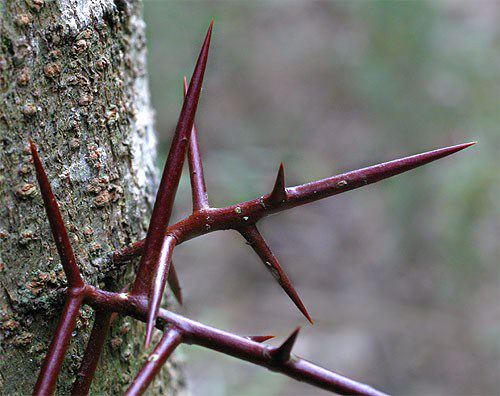Fletch
I'll Lock Up
- Messages
- 8,865
- Location
- Iowa - The Land That Stuff Forgot
From a tree. I kid you not.

Honey Locust (Gleditsia triacanthos)
There is one of these just outside my terrace level apt. Their chief characteristic, besides the seed pods various critters enjoy, is clusters of weapons-grade thorns.

These suckers are hard and sharp enough to deflate lawn tractor tires, but they give way easily to heavy nail clippers. Once I've harvested a decent batch, I carefully cut them to the length of the steel needles that go with my RCA acoustic portable. They give this usually bone-rattlingly loud phono a much softer tone, and supposedly, won't wear the records out so fast.
There is some trick to getting them in at the right angle - if you don't, they'll stop the turntable dead about 10 grooves in. Now I need to find one of those needle sharpeners folks used to use back in the day of cactus, bamboo, and various fiber needles.
I hadn't known this, but there is some historical precedent for what I'm doing:

Honey Locust (Gleditsia triacanthos)
There is one of these just outside my terrace level apt. Their chief characteristic, besides the seed pods various critters enjoy, is clusters of weapons-grade thorns.

These suckers are hard and sharp enough to deflate lawn tractor tires, but they give way easily to heavy nail clippers. Once I've harvested a decent batch, I carefully cut them to the length of the steel needles that go with my RCA acoustic portable. They give this usually bone-rattlingly loud phono a much softer tone, and supposedly, won't wear the records out so fast.
There is some trick to getting them in at the right angle - if you don't, they'll stop the turntable dead about 10 grooves in. Now I need to find one of those needle sharpeners folks used to use back in the day of cactus, bamboo, and various fiber needles.
I hadn't known this, but there is some historical precedent for what I'm doing:
We never knew how delightful our pet phonograph records could sound until one day, in a frenzy born of desperation, we substituted these long, sharp, honey locust thorns for the regulation needles. Now we use them through preference.
Yes . . . Mother Nature is kind to her children in the Ozarks.
-Marguerite Lyon, Take to the Hills: A Chronicle of the Ozarks, 1941